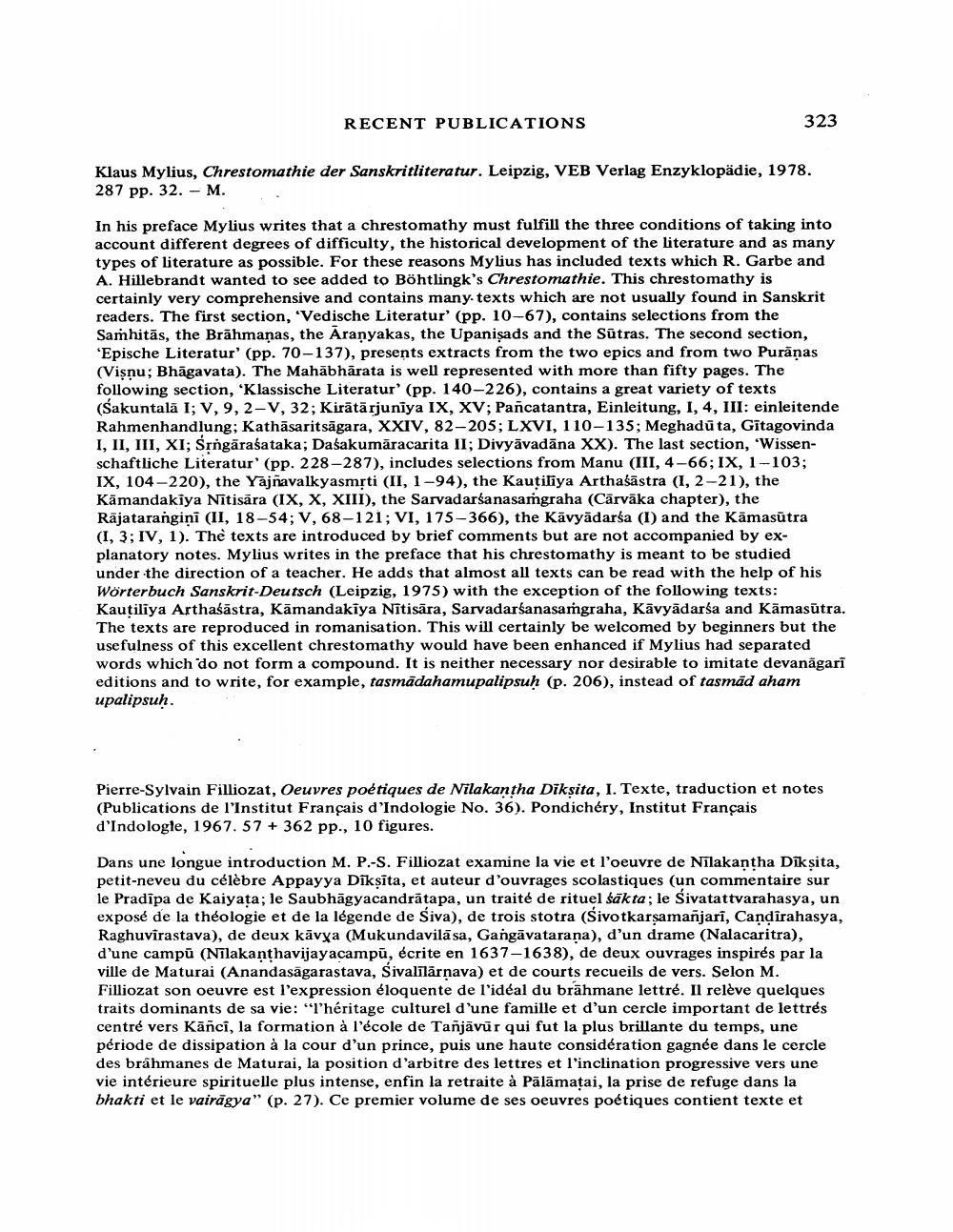Book Title: Recent Publications Author(s): Publisher: View full book textPage 5
________________ RECENT PUBLICATIONS 323 Klaus Mylius, Chrestomathie der Sanskritliteratur. Leipzig, VEB Verlag Enzyklopadie, 1978. 287 pp. 32. - M. In his preface Mylius writes that a chrestomathy must fulfill the three conditions of taking into account different degrees of difficulty, the historical development of the literature and as many types of literature as possible. For these reasons Mylius has included texts which R. Garbe and A. Hillebrandt wanted to see added to Bohtlingk's Chrestomathie. This chrestomathy is certainly very comprehensive and contains many. texts which are not usually found in Sanskrit readers. The first section, 'Vedische Literatur' (pp. 10-67), contains selections from the Samhitas, the Brahmanas, the Aranyakas, the Upanisads and the Sutras. The second section, 'Epische Literatur' (pp. 70-137), presents extracts from the two epics and from two Puranas (Visnu; Bhagavata). The Mahabharata is well represented with more than fifty pages. The following section, 'Klassische Literatur' (pp. 140-226), contains a great variety of texts (Sakuntala I; V, 9,2-V, 32; Kiratarjuniya IX, XV; Pancatantra, Einleitung, I, 4, III: einleitende Rahmenhandlung; Kathasaritsagara, XXIV, 82-205; LXVI, 110-135; Meghaduta, Gitagovinda I, II, III, XI; Sangarasataka; Dasakumaracarita II; Divyavadana XX). The last section, 'Wissenschaftliche Literatur' (pp. 228-287), includes selections from Manu (III, 4-66; IX, 1-103; IX, 104-220), the Yajnavalkyasmoti (II, 1-94), the Kautiliya Arthasastra (I, 2-21), the Kamandakiya Nitisara (IX, X, XIII), the Sarvadarsanasamgraha (Carvaka chapter), the Rajatarangini (II, 18-54; V, 68-121; VI, 175-366), the Kavyadarsa (I) and the Kamasutra (1. 3: IV. 1). The texts are introduced by brief comments but are not accompanied by explanatory notes. Mylius writes in the preface that his chrestomathy is meant to be studied under the direction of a teacher. He adds that almost all texts can be read with the help of his Worterbuch Sanskrit-Deutsch (Leipzig, 1975) with the exception of the following texts: Kautiliya Arthasastra, Kamandakiya Nitisara, Sarvadarsanasangraha, Kavyadarsa and Kamasutra. The texts are reproduced in romanisation. This will certainly be welcomed by beginners but the usefulness of this excellent chrestomathy would have been enhanced if Mylius had separated words which do not form a compound. It is neither necessary nor desirable to imitate devanagari editions and to write, for example, tasmadahamupalipsuh (p. 206), instead of tasmad aham upalipsuh. Pierre-Sylvain Filliozat, Oeuvres poetiques de Nilakantha Diksita, I. Texte, traduction et notes (Publications de l'Institut Francais d'Indologie No. 36). Pondichery, Institut Francais d'Indologie, 1967.57 + 362 pp., 10 figures. Dans une longue introduction M. P.-S. Filliozat examine la vie et l'oeuvre de Nilakantha Diksita, petit-neveu du celebre Appayya Diksita, et auteur d'ouvrages scolastiques (un commentaire sur le Pradipa de Kaiyata; le Saubhagyacandratapa, un traite de rituel sakta; le Sivatattvarahasya, un expose de la theologie et de la legende de Siva), de trois stotra (Sivotkarsamanjari, Candirahasya, Raghuvirastava), de deux kavga (Mukundavila sa, Gangavatarana), d'un drame (Nalacaritra), d'une campu (Nilakanthavijayacampu, ecrite en 1637-1638), de deux ouvrages inspires par la ville de Maturai (Anandasagarastava, Sivalilarnava) et de courts recueils de vers. Selon M. Filliozat son oeuvre est l'expression eloquente de l'ideal du brahmane lettre. Il releve quelques traits dominants de sa vie: "l'heritage culturel d'une famille et d'un cercle important de lettres centre vers Kanci, la formation a l'ecole de Tanjavur qui fut la plus brillante du temps, une periode de dissipation a la cour d'un prince, puis une haute consideration gagnee dans le cercle des brahmanes de Maturai, la position d'arbitre des lettres et l'inclination progressive vers une vie interieure spirituelle plus intense, enfin la retraite a Palamatai, la prise de refuge dans la bhakti et le vairagya" (p. 27). Ce premier volume de ses oeuvres poetiques contient texte etPage Navigation
1 ... 3 4 5 6 7
